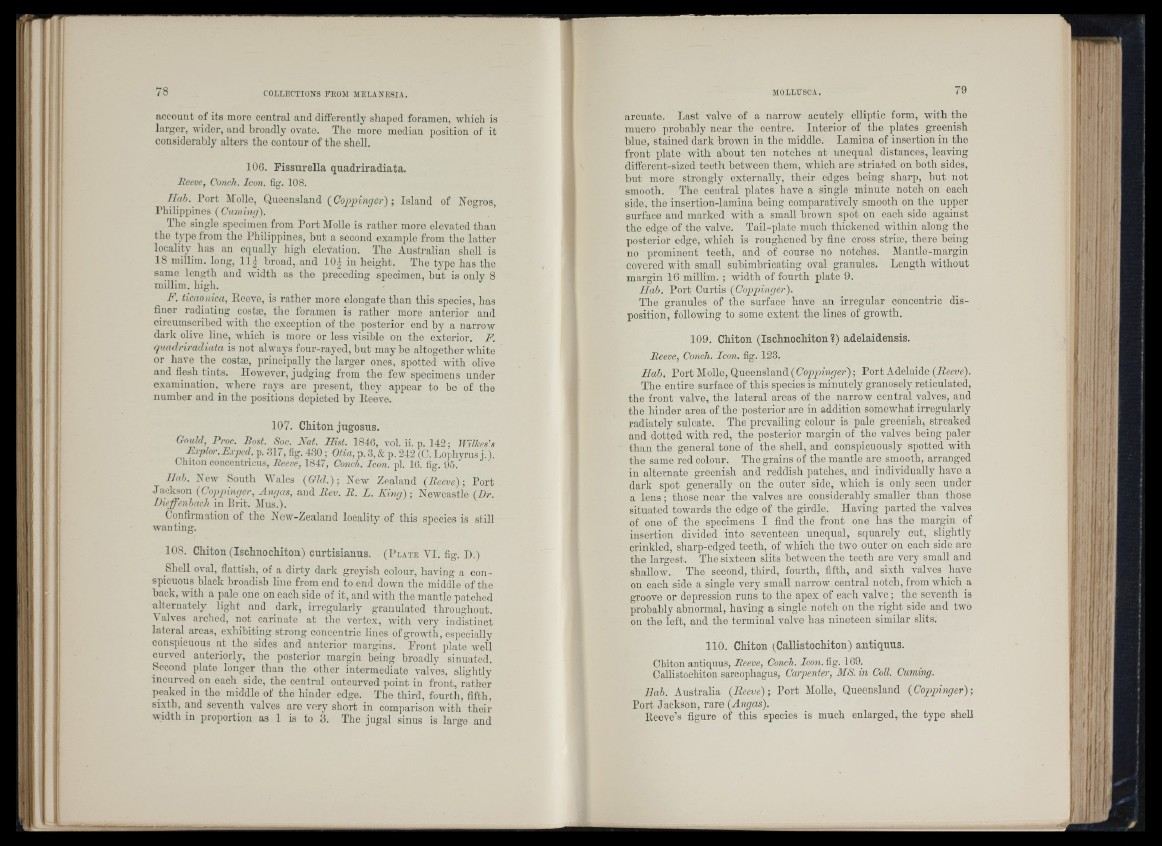
account of its more central and differently shaped foramen, which is
larger, Avider, and broadly ovate. The more median position of it
considerably alters the contour of the shell.
106. Fissurella quadriradiata.
Beeve, Conch. Icon. fig. 108.
Hah. Port Molle, Queensland (Coppinger); Island of Neirros
Philippines (Cuming).
The single specimen from Port Molle is rather more elevated than
the type from the Philippines, hut a second example from the latter
locality has an equally high elevation. The Australian shell is
18 millim. loug, 1 1 1 broad, and 1 0 | iu height. The typo has the
same length and width as the preceding specimen, hut is only 8
millim. high.
F. ticaonica, Reeve, is rather more elongate than this species, has
finer radiating costæ, the foramen is rather more anterior and
circumscribed Avith the exception of the posterior end by a narroAV
dark olive line, Avhich is more or less visible on the exterior. F.
quadriradiata is not always four-rayed, but maybe altogetherAvhite
or have the costæ, principally the larger ones, spotted Avith olive
and flesh tints. IloAvever, judging from the few specimens under
examination, where rays are present, they appear to be of the
number and in the positions depicted by Reeve.
107. Chiton jugosus.
Gould, Proc. Post. Soc. Nat. Hist. 1846, vol. ii. p. 142 ; Wilkes's
E.vplor.E.vped. p. 317, fig. 430 ; Otia, p. 3,& p. 242 (0. Lophvnis j.).
(yluton conceutricus, Beeve, 1847, Conch. Icon. pi. 16. fig. 95.'
Ilah. New South AAmles (Gld.) ; New Zealand (Beeve); Port
Jackson (Coppinger, Angas, and Rev. li. L . King); NeAvcastle (Dr.
Dieffenhach in Brit. Mus.).
Confirmation of the New-Zealand locality of this species is still
wauting.
10 8 . Chiton (Isehuochitou) curtisianus. (P la t e A*I. fig. D.)
Shell oval, flattish, of a dirty dark greyish colour, having a conspicuous
black broadish line from end to end down the middle of the
back, with a pale one on each side of it, and with the mantle patched
alternately light and dark, irregularly granulated throughout.
A u I a c s arched, not carínate at the vertex, A\dth very indistinct
lateral areas, exhibiting strong concentric lines ofgroAvth, especially
conspicuous at tho sides and anterior margins. Front plate Avell
curved anteriorly, the posterior margin being broadly sinuated.
Second plate longer than the other intermediate valves, slightly
incurved on each side, the central outcurved point in front, rather
peaked in the middle of the hinder edge. The third, fourth, fifth,
sixth, and seventh valves are A’ery short in comparison with their
Avidth in proportion as 1 is to 3. The jugal sinus is large and
arcuate. Last valve of a narrow acutely elliptic form, with the
mucro probably near the centre. Interior of the plates greenish
blue, stained dark brown in tho middle. Lamina of insertion in the
front plate with about ten notches at unequal distances, leaAung
differcnt-sized teeth betAveen them, which are striated on both sides,
but more strongly externally, their edges being sharp, but not
smooth. The central plates have a single minute notch on each
side, the insertion-lamina being comparatively smooth on the upper
surface and marked with a small brown spot on each side against
the edge of tho valve. Tail-plate much thickened within along the
posterior edge, which is roughened by fine cross striæ, there being
no prominent teeth, and of course no notches. Mantle-margin
covered with small suhimbricating oval granules. Length without
margin 16 millim. ; width of fourth plate 9.
Hab. Port Curtis (Coppinger).
The granules of the surface have an irregular concentric disposition,
following to some extent the lines of growth.
109. Chiton (Ischnochiton ?) adelaidensis.
Beeve, Conch. Icon. fig. 123.
Hab. Port Molle, Queensland (Qop^jmper); Port Adelaide (Beeve).
The entire surface of this species is minutely granoscly reticulated,
the front valve, the lateral areas of the narrow central valves, and
the hinder area of the posterior are in addition somewhat irregularly
radiately sulcate. The prevailing colour is pale greenish, streaked
and dotted Avith red, the posterior margin of the valves being paler
than the general tone of the shell, and conspicuously spotted with
the same red colour. The grains of the mantle are smooth, arranged
in alternate greenish and reddish patches, and individually have a
dark spot generally on the outer side, which is ouly seen under
a le n s ; those near the valves are considerably smaller than those
situated towards the edge of the girdle. Having parted the valves
of one of the specimens I find the front one has the margin of
insertion divided into seventeen unequal, squarely cut, slightly
crinkled, sharp-edged teeth, of AA+ich the tAVO outer on each side are
the largest. The sixteen slits between the teeth are very small and
shallow. The second, third, fourth, fifth, and sixth valves have
on each side a single very small narrow central notch, from which a
groove or depression runs to the apex of each valve; tho seventh is
probably abnormal, having a single notch on the right side and two
on the left, and the terminal valve has nineteen similar slits.
110. Chiton (Callistochiton) antiquus.
Chiton antiquus, Beeve, Conch. Icon. fig. 169.
Callistochiton sarcophagus, Carpenter, MS. in Coll. Cuming.
Hah. Australia (Beeve); Port Molle, Queensland (Coppinger);
Port Jackson, rare (Angas).
Reeve’s figure of this species is much enlarged, the type sheU
li
I <